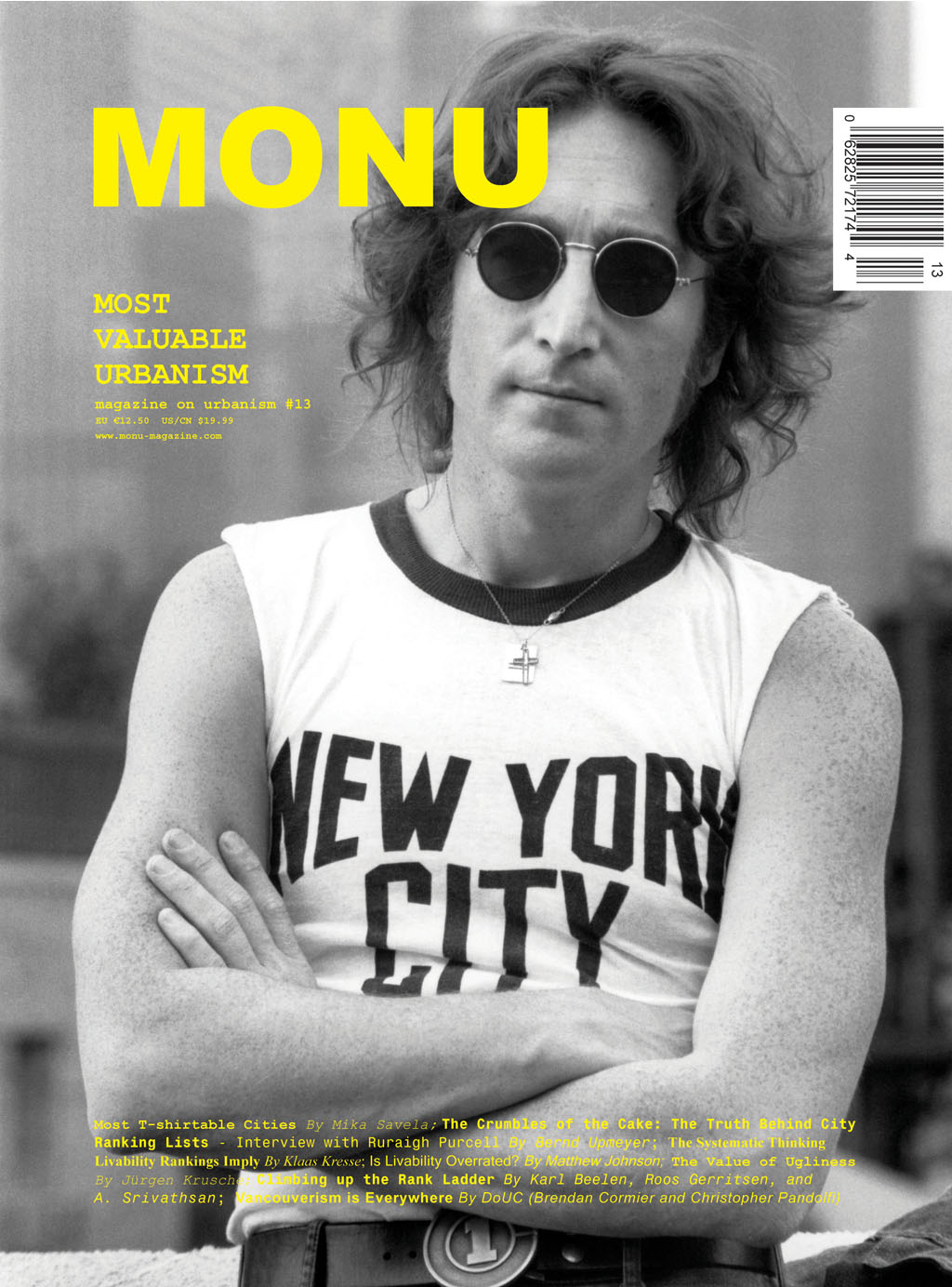05-10-10 // MONU #13 – MOST VALUABLE URBANISM

(browse the entire issue #13 on Youtube)
Most T-shirtable Cities By Mika Savela; Evaluation City – Post Industrial’s Most Valuable Urbanism By Melissa Dittmer and Amy Bos; Within a Day By Bobby Shen; Urban Perception of Happiness By Luciano Alfaya and Patricia Muñiz; The Urban Rhythm By Karin Aue and Jeffrey Koh; Tales of Nail Houses By Human Wu; Wonder Full By Bas van der Horst, Hans Larsson, and Michiel van Loon; The Crumbles of the Cake – Interview with Ruraigh Purcell By Bernd Upmeyer; The Systematic Thinking Livability Rankings Imply By Klaas Kresse; Is Livability Overrated? Notes on a Transactional Urbanism By Matthew Johnson; Berlin Tempelhofer Feld – A Field for the Public By Hans Frei; L.A.’s Optimistic Urbanism By John Southern; The Value of Ugliness By Jürgen Krusche; The Strategic City By Jennifer W. Leung; Climbing up the Rank Ladder By Karl Beelen, Roos Gerritsen, and A. Srivathsan; Vancouverism is Everywhere By DoUC (Brendan Cormier and Christopher Pandolfi); Vienna: Slow capital? By Stefan Gruber
When John Lennon was photographed by the legendary rock ‘n’ roll photographer Bob Gruen, wearing a New York City T-shirt in the year 1974, he proudly expressed his love for the city of New York. For Lennon, although born in Liverpool, New York City was without doubt the most valuable city. In that sense the value of a city can become extremely personal, subjective, and only a reflection of feelings, as Mika Savela argues in his contribution “Most T-shirtable Cities”. Because of this subjective experience the value of a city is – just as the beauty of a city – in the eye of the beholder and what constitutes ‘most valuable’, in whatever respect, shifts back into our hands, as Bobby Shen puts it in his piece “Within a Day”. People attribute a value to spaces that cannot be quantified in statistical terms, but is dependent on how ‘city users’ identify with the place where they live, as Luciano Alfaya and Patricia Muñiz explain in their article “Urban Perception of Happiness”. And this identification is usually based on rather intangible criteria; social, cultural, and psychological dimensions; or qualities such as history, identity, memories, or lifestyle, as Human Wu illustrates in his piece “Tales of Nail Houses”. Nevertheless, it would be naïve to exclude certain basic physiological needs out of the value discussion regarding cities. Those basic needs include, for example, security, housing, or health as Ruraigh Purcell, who spent several years running an analytical team producing city ranking lists, points out in an interview with us entitled “The Crumbles of the Cake – The Truth Behind City Ranking Lists”. In his opinion, basic, low-level needs have to be satisfied in a city, referring to Maslow’s Hierarchy of Needs, before you are in a position to move to a higher level of needs that would take in account things such as educational and cultural stimulus. Most of the evaluation criteria used by companies such as Mercer or the Economist Intelligence Unit to produce the famous city ranking lists that define the so called “most liveable cities”, are based mainly on those basic needs. But what is often less known is the fact that those ranking lists are not representative, as they use as a primary source the answers of a particular socio-economic group: expatriates. Klaas Kresse detects that fact in his text “The Systematic Thinking Livability Rankings Imply” and discloses that rankings are not made for the multiplicity of urban dwellers, but for a group of wealthy, well-educated and highly skilled professionals. He furthermore points out that the livability rankings imply an urban thinking in terms of closed systems as cities start focusing on the points already scored, which makes them static and inflexible. To continue being able to change Matthew Johnson proposes in his piece “Is Livability Overrated?” that cities should be allowed to exist in a state of perpetual upgrading and renovation – always under scaffolding, in the form of a transactional urbanism. In his eyes, Houston in Texas is such a transactional city that is evolutionary and voracious, and secure in itself, despite its imperfections. Jürgen Krusche misses such imperfections in the always top-ranked city of Zurich as he clarifies in his contribution “The Value of Ugliness”, where the constant striving toward clean, safe, and beautiful public spaces has banished unwelcome individuals from marginalized social groups from public life. But ever since the Economist began some ten years ago to rate cities such as Vancouver as the number one most livable city in the world, while other livability indices by Mercer and Monocle Magazine also gave it consistently high rankings, the safe and clean downtown living model of Vancouver became the planning model for cities around the world, as Brendan Cormier and Christopher Pandolfi explain in their article “Vancouverism is Everywhere”. Today, top positions in urban planning councils all over the world are filled with Vancouverities. However, there seems to be a resistance towards Vancouverism and there are possibilities to top livability ranking lists without following the trends, as Stefan Gruber explains in his text “Vienna: Slow Capital?”, in which he suggests that the quality of life in a city might also be determined by its capacity to resist certain movements and instead to concentrate on its unique attributes.
(Bernd Upmeyer, Editor-in-Chief, October 2010)
Find out more about this issue on MONU’s website.